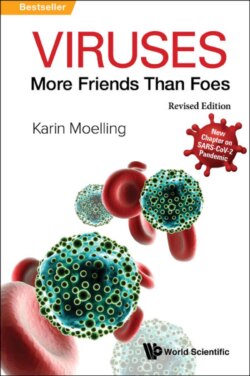Читать книгу Viruses: More Friends Than Foes (Revised Edition) - Karin Moelling - Страница 32
На сайте Литреса книга снята с продажи.
A sailor and splicing
ОглавлениеWhile I went on a sailing trip across the Baltic Sea on the three-masted schooner Lily Marleen, a sailor surprised me one morning with a present: a “spliced” rope. He had connected two ropes by “splicing” them together as a demonstration-piece for the students in my virology lectures. Splicing requires some skill, he said, and it kept him entertained during the boring night watches. A book entitled Splices and Knots teaches the art of these as used in sailing. A book with the same title could also be important in molecular biology. A splice is in a sense the opposite of a knot. Only when a rope is spliced can a sailor pass the connected pieces, quickly and without any hindrance, through the pulleys to pull up the sail; a knot would provide an obstacle to this. The same principle holds true in the molecular world. Double-stranded DNA is transcribed into single-stranded RNA, a flexible copy of the stiff DNA. The RNA — like a rope — can then be shortened by splicing: the rope is cut, a piece removed, and the ends that this produces are connected without knots — by splicing. The length of the pieces removed can differ, and now I can let another cat out of the bag: humans have the highest numbers of such removable portions per gene. That makes us more complicated than any other living animal. In this lies our uniqueness; perhaps we are after all the “crowning achievement of creation”.
Knot-free splicing (cleaving and joining) of RNA allows combinations of exons to build new genes with high complexity, intron is deleted.
Our genes are split, consisting of exons — regions that can be translated into proteins — and introns — regions in between, which are removed by cutting and splicing (rejoining) of the RNA ends. Human genes have on average approximately seven to nine exons, interspaced by introns. Think of a garden fence, with its planks and the spaces between them: these would correspond to the exons and introns respectively, although exons and introns are less regularly spaced. Furthermore, some introns can be very large (imagine a gate in the fence).
One can combine the various possible connections between introns and exons, whereby the introns are normally the parts deleted. The introns are not really “empty”, as gaps in the fence are. What information do they contain? They do not code for proteins, but direct and regulate the production of the proteins; they harbor regulatory information, determining where and when the proteins are to be produced. Thus the introns control the exons. Scientists used to think that the exons are more important, but today it is recognized that they are even the dependents. According to the scientific definition, exons “code” for proteins, whereas introns are “noncoding” (nc). The catalogue of known ncRNAs is a rapidly growing family of very important regulatory RNAs — almost a dozen of them were discovered recently. Therefore, dear reader, please remember “ncRNA”. The corresponding DNA is called ncDNA, which is transcribed to give the ncRNA. I find it particularly interesting that humans and the viruses are the joint world champions in splicing! Why the viruses? Because they make so much out of so little! (Our ancestors!) The sailor did not know how complex the background was behind the spliced rope that he gave me as a present.
As an example of generating many “messages” from a single all-embracing “message”, think of how many words you can generate from combined exons after splicing across any gaps: supercalifragilisticexpialidocious — not the longest English word, but the best-known for its length — just by deleting (but not rearranging) letters and thus created: super, supercilious, perfidious, precious, serious, superficial, fragile, pallid, series, focus; there are many more, and you may care to try for yourself. Viruses splice only within a word, as their minimalistic equipment comprises exons and no introns. In these different ways, we and the viruses have learnt to make the best possible use of our genetic material. This complexity lies at the heart of the complexity of the human organism, and that of the viruses, which is why I was doubly grateful for the sailor’s present.
